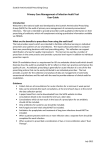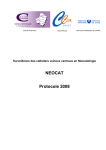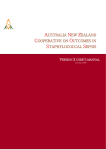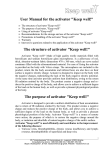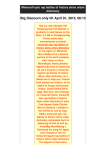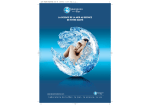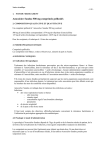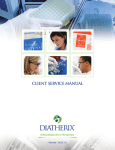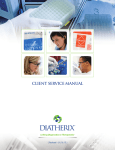Download Primary Care Antibiotic Prescribing Audit Tool User Guide
Transcript
Scottish Antimicrobial Prescribing Group 1 Primary Care Antibiotic Prescribing Audit Tool User Guide Introduction Welcome to the national tool developed by the Scottish Antimicrobial Prescribing Group (SAPG) for the audit of primary care management of commonly encountered infections. This audit tool is intended to provide prescribers with qualitative information on their prescribing of antibiotics. This information will complement existing quantitative information available via PRISMS. What are the benefits to prescribers from using the audit tool? The tool will provide information which is intended to facilitate reflective learning on individual prescribers own patterns of use of antibiotics. The information will allow prescribers to compare their own prescribing decisions with local prescribing policy. This reflection will support identification of areas for quality improvement. The tool can also be used by a number of prescribers in the same practice and provides a practice level report in addition to individual prescriber reports. With GP revalidation there is a requirement for GPs to undertake clinical audit. An important aspect of these audits is that the GP should illustrate how the audit has enabled them to reflect on their own practice and improve the quality of care. As antibiotic prescribing is generally for acute infection it is one of the few prescribing actions that can be easily attributed to an individual prescriber. This tool will provide a framework for the collection and analysis of data on management of commonly encountered infections and antibiotic use and fits well with the need to provide evidence of clinical audit for revalidation. Guidance Collect data on all consultations for acute infection for a minimum 2 week period. Data can be entered after each consultation, at the end of each day or at the end of the data collection period. A paper based form can be downloaded from the SAPG website to allow consultation details to be recorded for entry at a later date. Consultations which do not result in the issue of a prescription for an antibiotic should still be included. Only antibiotics for systemic use should be included. Anti-fungals and anti-virals should not be included. Antibiotics for prophylaxis and treatment of long term infections should not be included. When a patient presents with two or more infection sites a separate form should be completed for each infection. When a patient is prescribed a combination of two or more antibiotics select ‘Dual Therapy’. April 2012 Scottish Antimicrobial Prescribing Group 2 Welcome Screen When the audit tool is opened the Welcome Screen appears which includes guidance on inclusion and exclusion criteria. From the Welcome Screen the user can: Add a New Prescriber; Add Consultation Data; Run Reports and Exit the Application. Add a New Prescriber Before entering data the prescriber must add their name to the database. Click ‘Add a New Prescriber’ button on the Welcome Screen. The following form will appear. Enter the prescriber’s name in the text box. Click ‘Save Prescriber Name’ The form closes automatically To close the form without adding a new prescriber, click ‘Close Form’ April 2012 Scottish Antimicrobial Prescribing Group 3 Adding Consultation Data To add data click ‘Add Consultation Data’ button on the Welcome Screen. The following form will appear. Note: Database ID is an automatically generated number so this field does not have to be completed but should be added to the data collection form to enable prescribers to review the individual patient record as part of the process of reflection at the end of the audit. Add Consultation Date using the date picker Select Prescriber Name from the drop down menu Select the patient’s Age Group from the drop down menu Select the Infection Type from the drop down menu (a) If an antibiotic was not prescribed during the consultation: Select Antibiotic as ‘No antimicrobial prescribed - symptomatic relief / self care advice’. Further data fields are removed from the screen as shown below Data entry is complete Click ‘Save Record’ button Screen ready for next consultation April 2012 Scottish Antimicrobial Prescribing Group 4 (b) If an antibiotic was prescribed during the consultation: Select Antibiotic from the drop down menu If a dual prescription has been issued select ‘Dual Therapy’. Select Duration of Treatment from the drop down menu Indicate if a Delayed Prescription was issued (default is No) Select Indication for Treatment from the drop down menu Select Prescribing Method from the drop down menu Data entry is complete Click ‘Save Record’ button Screen ready for next consultation When all consultations have been added, click ‘Close Data Entry Screen’. Edit a Record If an error has been made during data entry then use the ‘Previous Record’ and ‘Next Record’ buttons to move between records. Edit the data within the record. Click ‘Save Record’ Delete a Record Use the ‘Previous Record’ and ‘Next’ Record buttons to navigate to the record you want to delete. Click ‘Delete Record’ button. The record has been removed from the database. April 2012 Scottish Antimicrobial Prescribing Group 5 Run Reports To produce reports click the ‘Run Reports’ button on the Welcome Screen. The following form will appear: A tabular and graphical version is available for each report by clicking the ‘Tables’ or ‘Charts’ button respectively. Further information about the reports can be found by clicking the button. Reports can be run at (a) Prescriber Level (default) To run a prescriber level report: Select ‘Start Date’ and ‘End Date’ for the period during which data were collected using the date pickers Select ‘Prescriber Name’ Select the report to be run by choosing ‘Tables’ or ‘Charts’ (b) Practice Level To run a practice level report: Uncheck the ‘Prescriber Level Report’ button Select the ‘Start Date’ and ‘End Date’ for the period during which data were collected using the date picker Select the report to be run by choosing ‘Tables’ or ‘Charts’ There are six reports available: (1) Consultation Summary The report provides a summary of all consultations relating to acute infection that took place between the specified start date and end date and includes a breakdown of all consultations by Age and Infection Type. April 2012 Scottish Antimicrobial Prescribing Group 6 The report summarises the number of consultations that resulted in the issue of a prescription. Consultations that resulted in the issue of a prescription are broken down by Indication for Treatment and Prescribing Method. The information on indication for treatment may be useful in interpretation of compliance with recommendations in local prescribing policies. Prescribing of antibiotics following telephone assessment should be limited to exceptional cases. (2) Antibiotics Summary The aim of antibiotic prescribing policies is to provide recommendations for the empirical treatment of commonly encountered infections to promote, safe, effective and economic use of antibiotics and to minimise the emergence of bacterial resistance. The report provides a summary of antibiotic prescribing for all consultations that resulted in the issue of a prescription between the specified Start Date and End Date and includes a breakdown of antibiotic use by Infection Type. This information should be interpreted in the context of local prescribing policies to identify areas for quality improvement. (3) Antibiotic Duration Summary Prescribing policies usually provide advice on the drug dose and duration for empirical treatment with antibiotics. The report provides a summary of antibiotic duration for all consultations that resulted in the issue of a prescription between the specified Start Date and End Date and includes a breakdown of antibiotic duration by Infection Type. This information may be useful in interpretation of compliance with recommendations in local prescribing policies. (4) No Prescribing Strategy: Upper Respiratory Tract Infections Prescribing guidance advises that antibiotics should only be prescribed when there is likely to be a clear clinical benefit and a no antibiotic strategy should be considered for acute self limiting upper respiratory tract infections. The report provides the number and proportion of consultations for upper respiratory tract infections (Acute Cough / Bronchitis, Otitis Media, Pharyngitis / Sore Throat / Tonsillitis and Rhinosinusitis) which did not result in a prescription for antibiotics between the specified Start Date and End Date. (5) Delayed Prescriptions: Upper Respiratory Tract Infections A delayed prescription strategy is recommended as an option for acute self limiting upper respiratory tract infections. The report provides a summary of consultations that resulted in a delayed prescription being issued for upper respiratory tract infections (Acute Cough / Bronchitis, Otitis Media, Pharyngitis / Sore Throat / Tonsillitis and Rhinosinusitis) between the specified Start Date and End Date. (6) Antibiotics with a higher Risk of Clostridium difficile Infection Antibiotic prescribing policies are intended to support a reduction in the use of antibiotics such as co-amoxiclav, ciprofloxacin and cephalosporins that are associated with a greater increased risk of CDI. The report provides a summary of infections treated using agents with a high risk of CDI between the specified Start Date and End Date. This information will enable prescribers to understand which infections have been treated using higher risk antibiotics. This information should be interpreted in the context of local prescribing policies to assess the appropriateness of this prescribing. April 2012 Scottish Antimicrobial Prescribing Group 7 Printing Reports Reports open in ‘Print Preview’ mode: The report can be printed by clicking the ‘Print’ button on the top left of the screen or closed by clicking the ‘Close Print Preview’ button on the top right of the screen. To exit the reports page click the ‘Close Reports’ button. Exit Audit Tool To close the application, click the ‘Exit Audit Tool’ button. April 2012 8 Scottish Antimicrobial Prescribing Group Primary Care Management of Infection Audit Tool Data Collection Form Patient CHI _______________ Patient Age 0-4 5-14 Database ID _______________ 15-29 30-44 45-59 Prescriber Name _______________ 60-74 75+ Infection Type Antibiotic Acute Cough / Bronchitis No antibiotic prescribed Cellulitis Amoxicillin Chronic Obstructive Pulmonary Disease Acute Exacerbation Azithroymcin Community Acquired Pneumonia Cefaclor Impetigo Cefalexin Otitis Media Cefradine Pharyngitis / Sore Throat / Tonsillitis Cefuroxime Pyelonephritis, acute Ciprofloxacin Rhinosinusitis Clarithromycin Urinary Tract Infection, Uncomplicated (Female) Co-amoxiclav Urinary Tract Infection, Uncomplicated (Male) Doxycycline Other Erythromycin Flucloxacillin Metronidazole Nitrofurantoin Phenoxymethylpenicillin Trimethoprim Other Dual Therapy Consultation Date _______________ Duration of Treatment 3 days 5 days 7 days 10 days >10 days Other Delayed Prescription Yes No Indication for Treatment Empirical treatment, first agent used Empirical treatment, second or subsequent agent Microbiologically confirmed infection, first agent used Microbiologically confirmed infection, second agent used Prescribing Method Face to face consultation Telephone request from patient Following receipt of laboratory information April 2012








